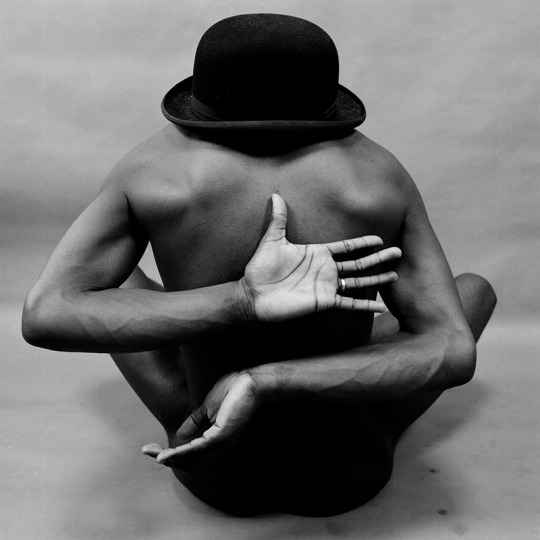#rotimi fani-kayode
Explore tagged Tumblr posts
Text

photographer: Rotimi Fani-Kayode
#Rotimi Fani-Kayode#male beauty#male aesthetic#men in art#male body#male photography#analog photography#photography#gay photography#africa#african culture#nigeria
80 notes
·
View notes
Photo

Sacrament of Bodies
Romeo Oriogun
In this groundbreaking collection of poems, Sacrament of Bodies, Romeo Oriogun fearlessly interrogates how a queer man in Nigeria can heal in a society where everything is designed to prevent such restoration. With honesty, precision, tenderness of detail, and a light touch, Oriogun explores grief and how the body finds survival through migration.
#queer history#I initially picked this up because the cover is a#Rotimi Fani-Kayode#and I loved it#very worth the read#so I thought I would share it here
843 notes
·
View notes
Text

Rotimi Fani-Kayode (Nigerian, 1955–1989), City Gent, 1988
62 notes
·
View notes
Text

Halt-Opened Eyes, Twins, Photo by Rotimi Fani-Kayode, 1989
110 notes
·
View notes
Text

Rotimi Fani-Kayode's 'Sonponnoi' 1987
"Within the Yoruba religion, the smallpox god was at one time powerful, feared and deadly if crossed. Sonponnoi was shunned by his fellow divinities or Orisha. The god was forced to roam the bush and his shrines were excluded from towns. As public anxiety around HIV transmission peaked, right wing groups and tabloid headlines whipped up majority prejudice against both gay men and Africans. Rotimi Fani-Cayode fell into both groups. He was also HIV-positive. The artist found a resonant symbol in the image of an outcast God, one that embodies infection, carrying the threat of death, yet also offers protection. During these painful years, other gay artists turned to St. Sebastian, already an established homoerotic pin-up. Sebastian’s old role as plague saint–both protector and sympathetic victim–came back to the fore in queer AIDS-themed art. It was Sebastian's arrow wounds that suggested to medieval Christians the plague sufferer’s pustules. Sonponnoi was also a spotted god. Cult carvings and ritual devotees alike were often covered with dots of paint to evoke the box's symptoms. During the crisis of the 1980s, the defining sign of AIDS-related illness in the public mind again became a pattern of skin markings, the purplish lesions of Kaposi's sarcoma. All these stigmata seemed to emerge in Sonponnoi, yet as the erect candle held by this unwelcome god reminds us, even the disease-bearing queer body feels the flame of desire."
From Pilcher, A. (2017). A Queer Little History of Art. London: Tate Publishing.
7 notes
·
View notes
Text

ROTIMI FANI-KAYODE photography
24 notes
·
View notes
Text
Das C/O wird 25! die Jahresvorschau für 2025
Mit über 250 Ausstellungen von mehr als 500 Künstler:innen, der Förderung von 250 Talenten sowie der Etablierung eines neuen Preisformats trägt C/O Berlin kontinuierlich neue Impulse in die Welt der Fotografie.

View On WordPress
#Aïda Muluneh#Atong Atem#C/O Berlin#C/O Berlin Talent Award#Dawit L. Petros#Délio Jasse#Edson Chagas#Fabrice Monteiro#George Osodi#Hassan Hajjaj#Kelani Abass#Kiripi Katembo#Kudzanai Chiurai#Lebohang Kganye#Maïmouna Guerresi#Malala Andrialavidrazana#Mário Macilau#Rotimi Fani-Kayode#Sabelo Mlangeni#Samson Kambalu#Zina Saro-Wiwa
0 notes
Text

Untitled, 1988, par Rotimi Fani-Kayode
Rotimi Fani-Kayode was a photographer who used his art to capture the black queer experience, to reject homophobia, and to fight for equal political representation during the AIDS crisis. Fani-Kayode was born in 1955 in Lagos, Nigeria, where his father was a politician and chieftain of Ife, the ancestral Yoruba capital. At age 11, Kayode and his family fled to Brighton, England to escape the Nigerian Civil War. He is also the founder of Autograph a nonprofit organization that helps black and minority photographers build their careers. Fani-Kayode created much of his work during the height of the AIDS crisis in response to the homophobia he witnessed in England under Margaret Thatcher and in his home country of Nigeria. Using the black body as his primary subject, Fani-Kayode explored themes of black queerness and cultural identity in a political call to action. His photographs combine African and European iconography to contest the marginal status of Yoruba culture and explore the position of the black body in Western society. In some images, Fani-Kayode incorporates elements of Yoruba spirituality into ironic signifiers of African “otherness” in a way that rejects the Primitivist themes of European modernism. Other images employ eroticism and moments of intimacy or communion to present queer sexuality as an act of healing and survival.
#rotimi fani kayode#allure#nude portrait#fine art nude#noir et blanc#photographic nude#homme#peau noire#black skin#lgbt
14 notes
·
View notes
Text

photographer: Rotimi Fani-Kayode
#male beauty#male aesthetic#Rotimi Fani-Kayode#men in art#male body#male photography#analog photography#photography#gay photography#africa#nigeria#african culture
36 notes
·
View notes
Text
Rotimi Fani-Kayode was a photographer, whose work was revolutionary for his time and remains so today. A gay man who came from Nigeria and moved from England to America, he had a diverse range of experiences around himself and his queerness, and he used his photography to translate those experiences into art.
Support Making Queer History on Patreon
Send in a One-Time Donation
#rotimi fani kayode#queer history#queer#lgbt#lgbt history#gay history#making queer history#nigerian history#british history#american history
181 notes
·
View notes
Text

Rotimi Fani-Kayode | Aesthetica
15 notes
·
View notes




